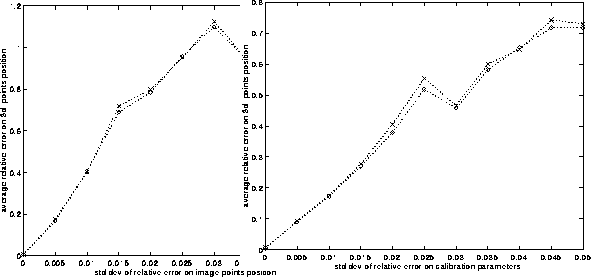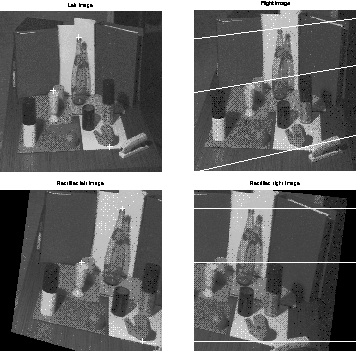


Next:
8 Discussion
Up:
Rectification with unconstrained stereo
Previous:
6 Summary of the
We ran tests to verify that the algorithm performed rectification
correctly, and also to check that the accuracy of the 3-D reconstruction
did not decrease when performed from the rectified images directly.

Figure:
Reconstruction error vs noise levels in the image coordinates (left) and
calibration parameters (right) for a synthetic stereo rig with camera
translation mm and rotation angles roll=
mm and rotation angles roll= pitch=
pitch= and yaw=
and yaw= . Crosses refer to reconstruction from rectified images, circles to
reconstruction from unrectified images.
. Crosses refer to reconstruction from rectified images, circles to
reconstruction from unrectified images.
The tests used both synthetic and real data. Each set of synthetic data
consisted of a cloud of 3-D points and a pair of projection matrices;
both points and matrices were chosen randomly, to cover a range of very
different stereo geometries and camera parameters. For reasons of space,
we do not show examples. Real-data experiments used several calibrated
stereo pairs available from the INRIA-Syntim WWW site, which include the
cameras' projection matrices [
12
]. Figure
2
shows an example. The right image of each pair shows three epipolar
lines corresponding to the points marked by a cross in the left image.
The output images are cropped to the size of the input images for
display purposes only; the pixel coordinates of the rectified images are
not constrained to lie in any special part of the image plane.
In order to evaluate the errors introduced by rectification on
reconstruction, we compared the accuracy of 3-D reconstruction computed
from original and rectified images. We used synthetic, noisy images of
random clouds of 3-D points and random stereo geometries, as explained
in the previous subsection. Imaging errors were simulated by perturbing
the image coordinates, and calibration errors by perturbing the
intrinsic and extrinsic parameters, both with additive, Gaussian noise.
As an example, Figure
1
shows the average (over the set of points) relative error measured on
3-D point position, plotted against noise, for one of the several
synthetic stereo rigs used for testing. Each point plotted is an average
over 100 independent trials. The abscissa is the standard deviation of
the relative error on coordinates of image point or calibration
parameters. It can be seen that the accuracy does not suffer when
reconstructing directly from the rectified images.

Figure 2:
Original ``Color'' stereo pair (top) and rectified pair (bottom). The
left pictures plot the epipolar lines corresponding to the point marked
in the right pictures.



Next:
8 Discussion
Up:
Rectification with unconstrained stereo
Previous:
6 Summary of the
Adrian F Clark
Wed Jul 23 16:48:44 BST 1997

 mm and rotation angles roll=
mm and rotation angles roll= pitch=
pitch= and yaw=
and yaw= . Crosses refer to reconstruction from rectified images, circles to
reconstruction from unrectified images.
. Crosses refer to reconstruction from rectified images, circles to
reconstruction from unrectified images.


